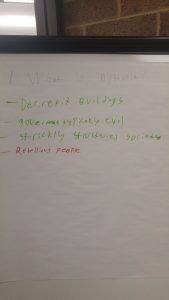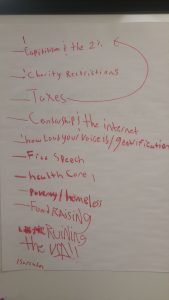I’m using this space to chronicle our journey into Dystopian Worlds & Transmedia Storytelling. These reflections will help me refine and improve my teaching, and maybe some others will also benefit! For my general observations on education and project-based learning, visit here.
11/13/2017
I spent time with each team guiding them through the process of clarifying roles, responsibilities, and assigning tasks. We are using Trello for project management, and all of the students are still learning how to use it effectively.
After our discussion, I was happy to see the struggling team was communicating much more clearly, and friendly collaboration was underway. As class was wrapping up, they were talking about getting together outside of class to accelerate their progress.
11/06/2017
One team of students is collaborating with ease; the other team not so much. I am always fascinated by how personalities within a group have such an enormous impact. This is magnified among teens, because they are hyper-sensitive to how they [think they] are perceived. In the struggling group, I perceive a great deal of frustration between the team members, which they are not talking about.
Part of the issue is that team roles and responsibilities are not clearly defined, even though the team members think they are. There are also interdependent tasks and one team member’s feet-dragging on getting his work done is impacting the others.
9/18/20177
The Big Task for the students today was to identify real-life dystopias they want to tackle with their transmedia stories. They each captured their own ideas on post-it notes, then organized them on chart paper. The major themes ended up being bullying in high schools, animal rights, and hunger/poverty/homelessness. They selected bullying and hunger (and its related issues) as the two topics they are going to develop.
The students then self-selected the teams they are going to work in and set to work creating Driving Questions. To help them in this process, I shared a few examples. I also gave each team a stack of index cards. On some of them, I had already written key words, such as “how,” “what,” “resolve,” “raise awareness,” “[town name],” “neighborhood,” etc. I asked them to structure an open-ended DQ which frames their work for the year. They came up with:
“How are we going to stop hunger in Aurora [a local community]?”
“How are we going to reduce bullying in local high schools?”
Again, I perceived that using “old-fashioned” techniques, paper, markers, index cards, etc. resulted in a more fluid process.
9/11/2017
Today was the first day of class. We have face-to-face classes just once a week, on Mondays. I was feeling anxious about launching this course, as well as the Meliora US History course (read about that here). I’m plunging into unknown territory with this transmedia gig. I took Coursera’s Transmedia Storytelling: Narrative worlds, emerging technologies, and global audiences last winter, and became totally excited. I could see the potential of having these teen students design and build a story across multiple media platforms.
I decided that our literature theme for the year would be “dystopia,” because that is a genre that most teens really enjoy. In conjunction with that, I planned that the students would identify real-world “dystopias” they would like to see resolved, and build group projects around them. One gigantic project for each group.
After ice breakers and other introductions to project-based learning (PBL), I asked the students what “dystopia” means; this is what they identified:
From there, we launched into a discussion about real-world “dystopias.” I expected the students to state ideas such as poverty and homelessness, maybe animal rights. However, their vision was even larger that I had foreseen:
I asked them to think about how they can bring these concepts to a local level, so that they can tackle it within our community and bring their ideas to class next week. Stay tuned!
Oh, yes, one other thing. For the past few years, I have had the students capture discussion notes in shared Google docs. This year, I decided to experiment with old-fashioned chart paper and markers. Maybe it’s my imagination, but I feel like the quality of engagement is much higher.

